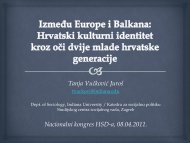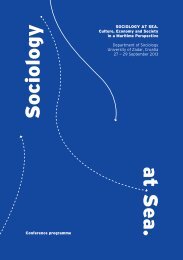rujan 2011. - Hrvatsko sociološko društvo
rujan 2011. - Hrvatsko sociološko društvo
rujan 2011. - Hrvatsko sociološko društvo
You also want an ePaper? Increase the reach of your titles
YUMPU automatically turns print PDFs into web optimized ePapers that Google loves.
‣ Josipovic-Jelic, Z., Sonicki, Z., Soljan, I., Demarin, V. and the Collaborative Group for Study of Epilepsy<br />
Epidemiology in Sibenik–Knin County, Croatia (2011). "Prevalence and socioeconomic aspects of epilepsy<br />
in the Croatian county of Sibenik–Knin: Community-based survey", Epilepsy and Behavior; 20: 686–690.<br />
http://www.sciencedirect.com/science/article/pii/S1525505011000643<br />
Sažetak. The aim of the survey was to estimate the prevalence rate of epilepsy, as well as seizure types, frequency,<br />
etiology, and comorbidity, by gender, age, and socioeconomic status among people with epilepsy in the Croatian<br />
county of Sibenik-Knin. The survey revealed that of 112,871 inhabitants, 1228 were identified as having active<br />
epilepsy. The crude prevalence rate for Sibenik-Knin County was 10.9 per 1000 inhabitants. Prevalence rates (per<br />
1000) by age and gender were: 6.9 (ages 0-19); 10.6 (ages 20-59); 15.1 (ages 60+), 10.1 (females), and 11.7 (males).<br />
A significant number of subjects had different comorbid disorders. Although the literature suggests that Dalmatia is<br />
a region with a low prevalence of epilepsy, our results showed that Sibenik-Knin County has a higher prevalence of<br />
epilepsy than expected for European populations. The most common comorbid disorders, such as mental retardation,<br />
psychotic episodes, and substance addiction, highly influence socioeconomic status and quality of life.<br />
‣ Kang, C. Handy, F., Hustinx, L., Cnaan, R., Brudney, J., L., Haski-Leventhal, D., Holmes, K., Meijs, L.,<br />
Pessi, A., B., Ranade, B., Smith, K., Yamauchi, N., Zrinščak, S. (<strong>2011.</strong>) What gives? Cross-national<br />
differences in students' giving behavior. The Social Science Journal, 48(2): 283-294.<br />
http://www.sciencedirect.com/science/article/pii/S0362331911000024<br />
Sažetak: This study is targeted to understanding the giving of time and money among a specific cohort – university<br />
students across 13 countries. It explores predictors of different combinations of giving behaviors: only volunteering,<br />
only donating, neither, as compared to doing both. Among the predictors of these four types of giving behavior, we<br />
also account for cross-national differences across models of civil society. The findings show that students<br />
predominantly prefer to give money than to volunteer time. In addition, differences in civil society regimes provide<br />
insights into which type of giving behavior might dominate. As expected, in the Statist and Traditional models of<br />
civil society, students consistently were more likely to be disengaged in giving behaviors (neither volunteering nor<br />
giving money) in comparison to students in the Liberal model who were more likely to report doing ‘both’ giving<br />
behaviors. An important implication of our findings is that while individual characteristics and values influence<br />
giving of time and money, these factors are played out in the context of civil society regimes, whose effects cannot<br />
be ignored. Our analysis has made a start in a new area of inquiry attempting to explain different giving behaviors<br />
using micro and macro level factors and raises several implications for future research.<br />
‣ Lažnjak, J., Šporer, Ž., Švarc, J. "Women in Science Commercialization: Looking for Gender<br />
Differences". Gender Technology and Development. 15 (2011) , 2; 175-200<br />
http://gtd.sagepub.com/content/current<br />
Sažetak: This article analyzes the participation of women in technology-oriented scientific projects (known as the<br />
TEST program) to identify gender-based differences in attitudes toward commercialization and innovation based on<br />
scientific research. The analysis is based on the TEST program that marks a milestone in science policy in Croatia,<br />
and represents a shift toward innovation policy. There is a higher representation of women project leaders in the<br />
TEST program than in the standard scientific projects. Our research started with the hypothesis that the higher proportion<br />
of women scientists in technology projects is related to gender differences in sociodemographic<br />
characteristics, in the motivation for application as well as implementation of the projects, and satisfaction with the<br />
results of the TEST program. The results confirmed gender differences only in scientific field, previous career<br />
positions, and num-ber of scientific publications, and do not offer an explanation of the relatively higher proportion<br />
of women researchers in TEST program. The findings indicate that once women scientists have an equal chance for<br />
commercialization, they perform as well as men do.



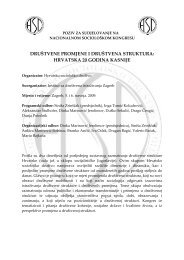

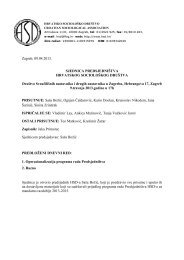
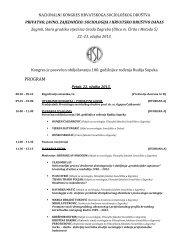
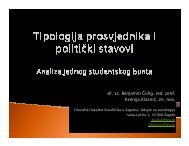
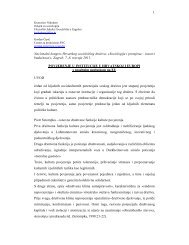
![PROGRAM SKUPA [pdf] - Hrvatsko sociološko društvo](https://img.yumpu.com/38770359/1/184x260/program-skupa-pdf-hrvatsko-socioloako-druatvo.jpg?quality=85)
